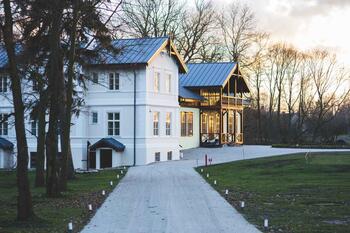
A “resort” community where there is no central commercial resort can still be a one-industry economy. In the case of the South Fork of Long Island (aka “Hamptons”), the one trick is luxury housing. There’s an extensive commercial/labor ecosystem to support it.
Of course, there are the houses themselves—nearly all of them being conceived big now, a few at 10,000 square feet or more. And during the pandemic, they’re being occupied for longer, which magnifies the demand for all the supporting businesses.
But first, they must be built or upgraded, likely then sold. After a brief interruption, Covid-19 has done wonders for that market. It brings a slew of custom contractors and their many “subs.” The realty agents flog the merchandise, sometimes before it is even finished. The lawyers and fixers make sure everything passes muster with the seemingly tight zoning and other codes.
Once the new occupants are “living the life” (as one Hamptons developer markets it), the real parade begins. The bigger the house (and wallet), the more likely that designers will be employed, both inside and out. The furnishings and appliances must be procured and delivered. The landscaping appears—sometimes with mature bushes and trees—and after implanted must be tended to weekly for much of the year. (Don’t forget the leaf blowers and chippers in the fall, especially.) There’s all the plumbing (bathrooms galore!) and wiring, and nowadays much of the latter entails entertainment networks and related utilities. Eastern Suffolk has limited sewerage and natural-gas hookups, so there are septic and propane calls on top of the heating oil fill-ups. Plus the garbage pick-ups…and the many, many “priority” package dropoffs. Most homes have a pool of some sort, and require servicing for five or six months of the year, along with any tennis court. And, my goodness, you have to eat! So, during a health scare, this means a lot of PeaPod and DoorDash. If by chance you are not in residence, there’s probably a caretaker or security patroller who is coming by to check on things.
Add all that up and you get virtually nonstop truck traffic on the often-winding roads, on top of the residents’ SUVs tending to their kids’ needs and other errands. As in other pricey areas, much of the “trades” inflow has to drive in and out each workday from less expensive digs miles away along a narrow strip. The backups only grow worse.
What do the data show about trades activity? Figures from the U.S. Bureau of Labor Statistics are imprecise as to this topic, but consider: For the Nassau-Suffolk County (Long Island, N.Y.) region, “mining, logging, construction” employment grew 42% between March 2010 and March 2020, whereas all private-sector jobs were up less than 12%. (And construction, unlike other sectors, had almost fully rebounded by October 2020 from the pandemic dropoff.)
Read the rest of this piece at timwferguson.com.
Tim W. Ferguson, the former editor of Forbes’s Asia edition, writes about business, economics and society.












